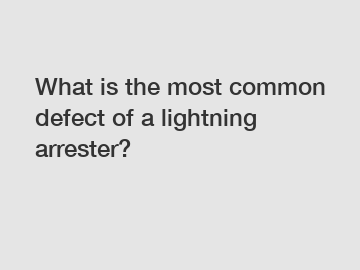What is the most common defect of a lightning arrester?
What is the most common defect of a lightning arrester?
Lightning arresters, also known as surge protectors, are essential devices used to protect electrical systems from the devastating effects of lightning strikes. They play a crucial role in safeguarding our homes, offices, and various electrical installations from power surges caused by lightning. However, like any other technical equipment, lightning arresters may face certain defects or issues over time. In this article, we will explore the most common defect of a lightning arrester and discuss various points related to it.
1. Insulation Failure:

One of the most common defects that lightning arresters can face is insulation failure. Insulation in the arrester is crucial because it prevents the lightning current from reaching the protected system. Over time, due to various environmental factors like heat, pollution, and humidity, the insulation material may degrade or weaken. This can lead to compromised insulation and subsequent failure of the lightning arrester.
2. Overvoltage Damage:
Lightning arresters are designed to handle high voltage surges caused by lightning strikes. However, prolonged exposure to multiple or severe lightning strikes can cause overvoltage damage to the arrester. This damage can occur at the internal components of the arrester, such as the metal oxide varistor (MOV) discs, rendering it ineffective in protecting against future lightning strikes.
3. Contamination and Moisture:
Contamination and moisture are other common factors that can affect the performance of lightning arresters. Dust, dirt, salt, and other pollutants accumulating on the arrester's surface can create a conductive path, allowing leakage current to flow through and compromising its efficiency. Moisture, whether from rain, humidity, or condensation, can also degrade the insulation and lead to arrester failure.
4. Aging and Wear:
Lightning arresters, like all electrical equipment, have a limited lifespan. Over time, the components of the arrester may age, wear, or deteriorate due to continuous exposure to electrical stresses. Aging can lead to a decrease in the arrester's protective capability and an increased risk of failure. Regular maintenance and periodic replacement are crucial to ensure the arrester's effectiveness.
In conclusion, the most common defect of a lightning arrester is insulation failure. However, it is essential to note that lightning arresters are built to withstand high voltage surges and protect electrical systems effectively. To minimize the risk of defects, regular maintenance, periodic inspections, and following manufacturer recommendations are crucial. Ensuring a clean and dry environment around the arrester, protecting it from external pollutants, and replacing the arrester when it reaches the end of its expected lifespan are vital for maintaining its functionality and protecting electrical systems from lightning-induced damages. Always consult with professionals and experts when it comes to choosing, installing, and maintaining lightning arresters to ensure optimal safety and performance.
For more outdoor prefabricated substation factory, ggd switch cabinet, withdrawable switchgearinformation, please contact us. We will provide professional answers.


